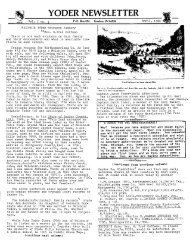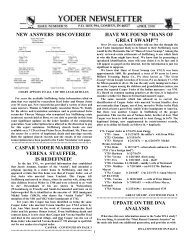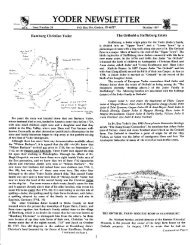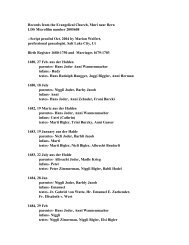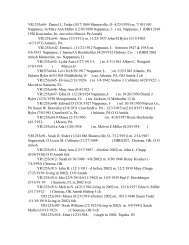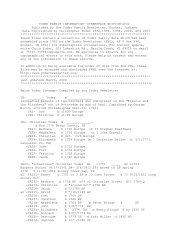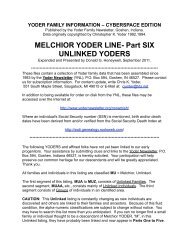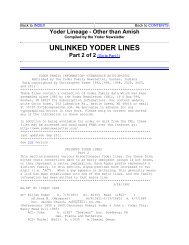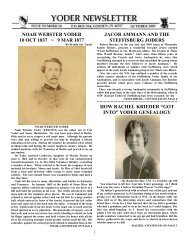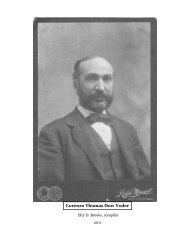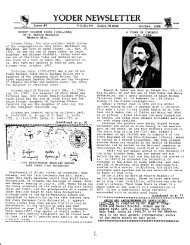Day 1 - Yoder Family Information
Day 1 - Yoder Family Information
Day 1 - Yoder Family Information
You also want an ePaper? Increase the reach of your titles
YUMPU automatically turns print PDFs into web optimized ePapers that Google loves.
Opening remarks<br />
This is the third time the <strong>Yoder</strong>s of North Carolina have sponsored a National<br />
<strong>Yoder</strong> reunion. I well realize the amount of hard work which is involved. And<br />
I can't begin to say enough to thank our southern cousins for this wonderful<br />
gift to us all.<br />
This time it is especially meaningful because we have the clearest view in<br />
almost 300 years of the connections of the early <strong>Yoder</strong>s to one another.<br />
Cover<br />
------------------------------------------------------------------------<br />
Good afternoon. Dr. <strong>Yoder</strong> told about what is probably the most historic rediscovery<br />
in the past 300 years of <strong>Yoder</strong> history. We at the <strong>Yoder</strong> Newsletter<br />
are celebrating a milestone of a somewhat lesser note, our 30th anniversary in<br />
print. So I decided I'd give you an overview of these last 30 years, what we<br />
knew then and what we've learned, and some of the people along the way who<br />
have helped.<br />
Overview:<br />
I'll tell about the Newsletter, about the family name, the European research,<br />
the major American lines and growth of our family in America, and some of<br />
the <strong>Yoder</strong> events since 1983.<br />
30 Years<br />
Here you see our first issue in 1983, and our most recent one. How many are<br />
subscribers? Thank you. For those of you who are not subscribers, I have<br />
some copies of our 30th anniversary issue that you are welcome to pick up<br />
after the presentation.<br />
The Beginnings<br />
I had developed an interest in the history of the <strong>Yoder</strong> family years ago and in<br />
the 70s had the chance to begin doing some research into my own family when<br />
my wife and I lived in Pennsylvania. After two children and moving around a<br />
bit with my job, we found ourselves in Battle Creek Michigan. At that time a<br />
company named "Beatrice Bailey" was publishing a "<strong>Yoder</strong> Book" , which
ended up being little more that a collection of <strong>Yoder</strong> names and addresses<br />
from phone data bases.<br />
I was very curious about all the different branches of the family, and I saw<br />
these addresses as an opportunity to begin contacting <strong>Yoder</strong>s across to<br />
country. So I wrote to Rachel Kreider, a recognized <strong>Yoder</strong> scholar. She and<br />
her husband were about to move from Ohio to a retirement community in<br />
Goshen Indiana, not far from us, and she knew of a retired school principal<br />
living there named Ben <strong>Yoder</strong> who had a similar interest to my own. After she<br />
was settled in, we got together at her kitchen table in Goshen. With her help<br />
and knowledge Ben and I put together an initial issue and sent out several<br />
thousand copies over the space of the next several months, along with a family<br />
history sheet which people could fill-out and return. That was the beginning.<br />
I'd like to introduce you to our staff…<br />
Rachel<br />
First off Rachel, our senior editor. She began collecting <strong>Yoder</strong> data with her<br />
Uncle John Weaver in the 1930s. In the 50s she wrote an article about the St.<br />
Joder Chapel for a Mennonite magazine, has written books on Ohio<br />
Mennonite cemeteries and with Dr. Hugh Gingrich, in 1986 publish what is<br />
the authoritative book on the Amish family histories - "Amish and Amish<br />
Mennonite Genealogies". She has been the "go-to person" on <strong>Yoder</strong><br />
genealogy for many many years. Now 103 years old, she has slowed down a bit<br />
in her envelope stuffing, but still proofs the draft of each issue to catch my<br />
typographical or grammatical errors.<br />
Ben <strong>Yoder</strong><br />
The co-founder of the newsletter…. He loved the human interest fun stories<br />
about the <strong>Yoder</strong>s, while I've always focused on harder facts and solving<br />
mysteries. For the first ten years of the <strong>Yoder</strong> Newsletter, we would meet at<br />
his kitchen table with scissors and glue, and put together each issue over the<br />
space of a Saturday's effort. It was a tremendous loss of a partner and friend<br />
when he died just short of our 20th issue at the age of 80 while my family and<br />
I were living and working in Saudi Arabia.<br />
John W, <strong>Yoder</strong>
Not long before his death, Ben had wisely recruited some younger help. John<br />
W. <strong>Yoder</strong> of Middlebury, came on board to help us maintain the subscriber<br />
information and generate our mailing labels for each issue. He quickly<br />
stepped in to keep things going, and I was able to prepare the newsletters by<br />
long distance and get them to our printer in Goshen without interruption.<br />
John has continued as our Circulation Manager for over 20 years and I'm so<br />
glad he and his family are with us today. John..<br />
Esther<br />
Esther <strong>Yoder</strong>, who I first met at the 1995 <strong>Yoder</strong> reunion here in Hickory, had<br />
with her husband been active in building of the House of <strong>Yoder</strong> in Grantsville.<br />
Soon after our meeting, they moved to the Mennonite retirement center in<br />
Goshen and she took over the role of managing our mail, both incoming and<br />
outgoing.<br />
Donald Kauffman<br />
In the 90s the technology of things changed, and the newsletters could be<br />
composed in Microsoft Word and emailed to the printer.<br />
We also started putting our accumulated files of <strong>Yoder</strong> data on-line,<br />
uploading records to a server in Santa Barbara, California. We decided what<br />
we needed was an actual web page, so a call went out in 1996 for a volunteer<br />
webmaster. Answering the call was Donald Kauffman of Edmonton Alberta.<br />
Don is also the creator of the "Mennobits" research tool of collected Amish<br />
and Mennonite obituaries now maintained by the Historical Committee of the<br />
Mennonite Church.<br />
So that's our staff today… all volunteers.<br />
The <strong>Yoder</strong> name<br />
Historians trace the surname <strong>Yoder</strong> to St. Theodorus, "Joder" a missionary<br />
monk who brought Christianity over the Alps from Italy in the 4th century<br />
AD. In 1483 the chapel pictured here was dedicated to him, and was<br />
refurbished in the last century by European Joders. In 1981 Luxembourg<br />
issued a stamp to commemorate the 1600th anniversary of his appointment as
ishop. The Swiss Reformed Church celebrates Aug 16 as "St. Joder's day"<br />
so naturally we American <strong>Yoder</strong>s do too. Greeting cards can be downloaded<br />
and printed or emailed from the <strong>Yoder</strong> website, and we have a new contest<br />
going to add more cards to the selection.<br />
Meaning of the name<br />
The name comes from the greek- Theos meaning God and doron meaning<br />
gift. So I hope all you spouses of <strong>Yoder</strong>s are appropriately appreciative of<br />
your gifts… I know my wife sometimes is not.<br />
What we Knew<br />
When we started the newsletter, we knew about several main lines of <strong>Yoder</strong>s<br />
in America.. Only the first <strong>Yoder</strong>s, who settled in the Oley Valley of Berks<br />
County had their connection established to the Old World. Next were the<br />
Menonite <strong>Yoder</strong>s of Buck Lehigh co Pa, and in 1742 a large family of Amish<br />
<strong>Yoder</strong>s. In the mid century Conrad <strong>Yoder</strong> arrived and within a few years<br />
moved to NC to begin the line of our hosts today. In the 1800s a score or more<br />
of other <strong>Yoder</strong> immigrants made their way to America from Alsace and<br />
Germany. Where did we come from?<br />
In Switzerland<br />
• “"The Swiss encyclopedia locates our "ancient family" in the village of<br />
Steffisberg in the canton of Bern in the 14th century. At Steffisberg the<br />
Joders began to appear in the records as early as 1529 and at Muri<br />
slightly later."<br />
European Resaerch<br />
We are all very indebted to European researchers Karl Joder and Otmar<br />
Jotter who over 30 years ago studied, collected, and shared information about<br />
our early Joders.<br />
Lineage<br />
They pieced together a Joder lineage going back to the 13th century.. which<br />
was about the time in Europe that surnames began to be used… I've show it<br />
on this chart and refer to it as "apocryphal" because when you are working<br />
with bits and pieces of church and other documentation, you have to make
assumptions when you claim relationships…. But in all likelihood many on<br />
this tree are actually ancestors of those in this room…of particular interest to<br />
American <strong>Yoder</strong>s is the family of Caspar Joder who m. Margret Henning in<br />
1596.<br />
Caspar <strong>Family</strong><br />
Two children of Caspar have been a focus as the possible origin of American<br />
<strong>Yoder</strong> for many years. Jost Joder b. 1607 and his brother Niclaus b<br />
1609…both married cousins named Ann Trachsel on Oc 14, 1642. The recent<br />
findings have confirmed that these were proper choices. Children from these<br />
two families left Steffisburg in the 1690s.<br />
Joder Families in Europe<br />
These Joders initially settled in Alsace and the German Palatinate. Some<br />
descendants remain in these areas today, others moved on to America.<br />
American <strong>Yoder</strong> Immigrants<br />
Here are the major batches of American <strong>Yoder</strong>, and I'll say a bit about each<br />
one. How many of you here today are descended from: The Oley <strong>Yoder</strong>s? The<br />
Mennonite <strong>Yoder</strong>s? the Conrad <strong>Yoder</strong> line? The Amish <strong>Yoder</strong>s? The<br />
Melchior <strong>Yoder</strong>s? The Alsatian <strong>Yoder</strong>s? Any others?<br />
Oley Valley<br />
Our first <strong>Yoder</strong>s were Hans and his brother Jost. They were grandsons of<br />
Niclaus Joder we talked about and were born in Steffisburg. In 1709 Hans left<br />
the German Palatinate for "the island of Pennsylvania" --- Dr. Don <strong>Yoder</strong><br />
found the church record of this seen here through a German collaborator .<br />
Hans settled on his property in the Oley Twp of Berks Co Pa in 1714…300<br />
years ago next year.<br />
Oley Researchers<br />
In addition to Dr. <strong>Yoder</strong>, we can credit a number of others, including: Dr.<br />
Peter Bertolet, a <strong>Yoder</strong> descendant who documented local history in the 19th<br />
century; Dick <strong>Yoder</strong> of Bechtelville, PA, who has done significant research<br />
into the land, church records, and wills of the Oley <strong>Yoder</strong> line, and has<br />
shared this all with the newsletter; and the late Walter and Mae Moore, who
esearched the Jacob <strong>Yoder</strong> family of Lewisburg, PA…which is now proven<br />
to be connected to the Oley <strong>Yoder</strong>s.<br />
Reunion scenes<br />
Here are some scenes from one of the national <strong>Yoder</strong> reunions hosted by the<br />
Oley <strong>Yoder</strong>s.<br />
Oley <strong>Yoder</strong> Chart<br />
Here is a chart of the first two generations of the Oley <strong>Yoder</strong>s. An estate<br />
settlement held in family hands for over 200 years was recently given to the<br />
Berks Historical Society and it allowed us to fill out the family details for<br />
immigrant Yost <strong>Yoder</strong>. Don <strong>Yoder</strong> wrote a major article on this find for<br />
newsletter 57.<br />
Hans <strong>Yoder</strong> of Great Swamp<br />
Hans <strong>Yoder</strong> "of Great Swamp" referring to the area in which he settled, was<br />
the next <strong>Yoder</strong> arrival that we know of. He settled in Bucks County<br />
Pennsylvania and was a Mennonite. The family kept this religious link for<br />
many generations as it spread from Bucks/Lehigh Cos in Pa into Ohio and<br />
Indiana.<br />
Mennonite <strong>Yoder</strong> researchers<br />
We can thank Ken Hottle for figuring out the early generations of this line.<br />
Richard Yothers, researched and documented the line of one of Han's<br />
grandsons who took on the spelling YOTHERS. Actress Tina Yothers of the<br />
TV show <strong>Family</strong> Ties is from this family. Leonard G. <strong>Yoder</strong> researched and<br />
documented the Ohio branch of the family in the 1940 and 1950s.<br />
Hans Discovered<br />
A couple years ago, the <strong>Yoder</strong> Newsletter hired a professional to research and<br />
transcribe Steffisburg Joder estate records held in Bern, and these let us<br />
correct the relationships between several families in the key emigrant<br />
Steffisburg generations. One was the family of Niclaus' son Caspar, who had<br />
children both in the Palatinate and remaining in Steffisburg. Caspar's son<br />
Hans, born 1677, was referred to by 1724 as "in some foreign country,<br />
moreover it is not know if he's alive"
Our Mennonite Hans<br />
Our Mennonite Hans had been born "about 1680", was in PA before 1720,<br />
and his is the only known <strong>Yoder</strong> line in American to use the name "Caspar"-<br />
both in his children and grandchildren's generation, We believe it very likely<br />
this is the same fellow.<br />
The Amish <strong>Yoder</strong>s<br />
Families of Christian and "the widow Barbara" <strong>Yoder</strong> (whose husband is said<br />
to have died at sea) arrived in Philadelphia, Sept 21, 1742. They settled in<br />
Berks County, PA further north of the Oley <strong>Yoder</strong>s. Known Amish<br />
connections in the family of the Steffisburg Jost Joder are supported by DNA<br />
testing which points to the Amish <strong>Yoder</strong>s as his descendants. I'll go into more<br />
detail about the <strong>Yoder</strong> DNA testing Sunday.<br />
Amish Researchers<br />
As the Amish tend to marry within the community, we have some excellent<br />
historical data and books on those families. Harvey Hochstetler wrote two<br />
large volumes in the early 1900s, and these have been augmented by many<br />
others. Most significant was the 1986 publication by Dr. Hugh Gingerich and<br />
our own Rachel Kreider of The Amish and Amish Mennonite<br />
Genealogies…which is and extensive outline of the Amish families through<br />
1850.<br />
Amish Scenes<br />
Here are some Amish <strong>Yoder</strong> scenes from Berks County, where the Northkill<br />
congregation was our first community<br />
Conrad <strong>Yoder</strong> of NC<br />
Conrad <strong>Yoder</strong> is the forebear of our NC hosts. He arrived in 1746 in PA, and<br />
then moved on to NC in 1753, buying land here in 1763.<br />
Conrad Researchers<br />
We've heard about George M. <strong>Yoder</strong> and his grandson Fred Roy <strong>Yoder</strong>, who<br />
have done so much to document the family history. The late Hubert <strong>Yoder</strong> of<br />
Charlotte, and Anne McAllister, who authored a 2 volume history of Heinrich
Weidener, worked for years to unveil information on the family of sons who<br />
moved to Indiana, Tennessee, and Iowa.<br />
Conrad Chart<br />
Here's his chart. The NC <strong>Yoder</strong> book limits itself to sons John and David,<br />
whose families stayed in North Carolina.<br />
The Mussbach Confirmation Record<br />
This is the 1740 confirmation record from Mussbach Germany which Dr.<br />
<strong>Yoder</strong> spoke of Friday. It has provided the key to the mystery of Conrad's<br />
relationship to the <strong>Yoder</strong>s of Steffisburg. By giving his age, we also are able to<br />
identify his year of birth as 1725.<br />
Updating the NC <strong>Yoder</strong> Book<br />
In the first sentence of his 1970 <strong>Yoder</strong>s of NC book, Fred <strong>Yoder</strong> credits Dr.<br />
Don <strong>Yoder</strong> for his information on the <strong>Yoder</strong>s in Europe, citing a pamphlet<br />
Don wrote in the early 1950s.<br />
For several years, there has been talk of updating the book to include the<br />
other children and now we have these wonderful new discoveries on Conrad's<br />
origins.<br />
Update part 2<br />
Dr. <strong>Yoder</strong> has been preparing a new forward for the book, the original text<br />
has all been OCR'd and is ready to be worked with, the YNL has aggregated a<br />
starting point of information on the other lines. What is needed now is a<br />
project manager and some volunteers, to do further review of census and<br />
other records, formatting, and clean-up work for a new edition. I would hope<br />
that some of you within the Conrad family will step forward to take this on.<br />
Melchior <strong>Yoder</strong><br />
We have learned over the years that Melchior <strong>Yoder</strong> was born in Weidenthal<br />
in 1736 to a Niclaus Joder, naturalized in America in 1765, and that he<br />
corresponded with Conrad <strong>Yoder</strong> in NC..<br />
Researchers of Melchior
We first learned about Melchior through an article in YNL 3 by Dorothy<br />
<strong>Yoder</strong> Coffman. We also have Dorothy to thank for many of the early <strong>Yoder</strong><br />
census transcriptions which are available on the Newsletter webpage. It is<br />
interesting to see that just at the time the Melchior-Conrad connections are<br />
becoming clear, the families have been connected in another way, with the<br />
marriage of Dorothy <strong>Yoder</strong>'s granddaughter to a Conrad <strong>Yoder</strong> descendant!<br />
Carl <strong>Yoder</strong>s (with an S) worked for years to successfully establish the identity<br />
of his SW PA ancestor as a son of Melchior. And "Melchior Line<br />
Coordinator" Don Honeywell and his wife Grace have spent years of effort to<br />
build the most complete descendant information that we have for any of the<br />
immigrant lines. Don and Grace are here today….<br />
Alsatian <strong>Yoder</strong><br />
The Alsatian <strong>Yoder</strong>s started to come to the US in the 1800s, and arrived in<br />
NY, OH, and Indiana. These folks were Amish and while the French<br />
researcher who provided much of our data claims they link to one particular<br />
son of Jost of Steffisburg, we as yet have no evidence to prove this.<br />
German immigrants<br />
Other <strong>Yoder</strong>s came in the 1880s from Germany- some of these were Amish,<br />
and had the Amish DNA profile (which I'll talk about on Sunday), and some<br />
did not.<br />
Rose by any other name<br />
I call this my "rose by any other name" chart. From the different family lines,<br />
all apparently originating with the Joder family of Steffisburg, we have<br />
descendants with the following spellings: <strong>Yoder</strong>, <strong>Yoder</strong>s, Yother, Yothers,<br />
Youther, Yotter, Jotter, Joder, Ioder, Yoter, Yetter).<br />
The Conrad Discovery<br />
Dr. <strong>Yoder</strong> went into some detail about this wonderful discovery. Here you can<br />
see what it all means pictorially. (USE POINTER)<br />
Oley immigrants Hans and Jost were the uncles of Conrad.<br />
Conrad was the uncle of Melchior <strong>Yoder</strong>.
Don shared very interesting stories about various American cousins….one<br />
was Philip Lahr (c1734 -
Pictures 2<br />
How about the 2000 reunion?<br />
2014-300th anniversary<br />
Two years from now will be the 300th anniversary of the Oley <strong>Yoder</strong><br />
homestead in Berks County. Plans are underway by the Oley <strong>Yoder</strong>s to host<br />
another national reunion, in commemoration of this milestone. The newsletter<br />
will give more information as the plans unfold.<br />
YNL On the Web<br />
I mentioned our webmaster, Don Kauffman, and his work. On our web pages<br />
we have family tree data, census records, church and civil records from<br />
America and Switzerland, old newsletters, and much, much more…<br />
In 2010 we joined the "Facebook" world and today have almost 600 "friends"<br />
there…how many of you are on facebook? Have you all "liked" the<br />
newsletter?<br />
House of <strong>Yoder</strong><br />
Ray Yount gave us a tour Friday of the House of <strong>Yoder</strong>.<br />
Thanks to our hardcopy newsletter subscribers, we've had a kitty to do many<br />
things.. including mailouts for the national reunions, paying for some of the<br />
European research, and many DNA tests. We were also able to make<br />
substantial contributions to the building of the House of <strong>Yoder</strong> in Grantsville,<br />
and recently gave another $500 for the refurbishing of its roof.<br />
In Summary<br />
In summary, here's what we look like……30 years ago we were a bunch of<br />
lines leading up to question marks. There are still question marks, but the<br />
lines are much clearer, and we know we can truly call each other "cousin".<br />
TALK THE CHART WITH POINTER<br />
Steffisburg Joders- Nicolaus's descent- Josts- both proven and linked by DNA
Thank you Chart<br />
In conclusion, I'd like to thank you all for your support of the <strong>Yoder</strong><br />
Newsletter over the years, and for your attention this afternoon. Please enjoy<br />
the wonderful fellowship of all those here assembled thanks to the North<br />
Carolina <strong>Yoder</strong>s.<br />
May God continue to Bless you all, as he's blessed our family over the<br />
generations.



